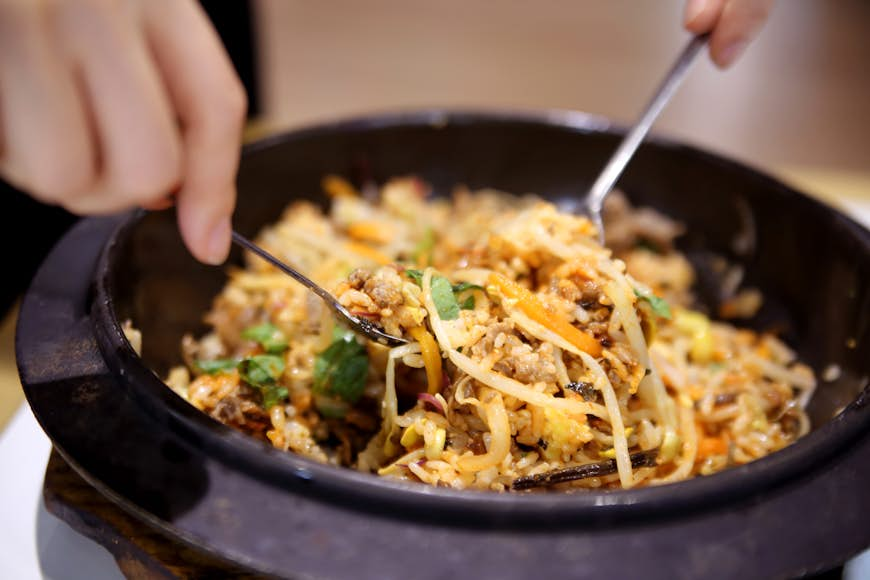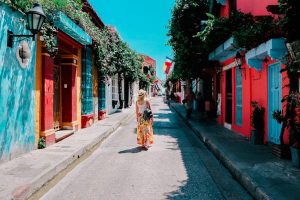
In Korea, food is for the soul as well as for the stomach. Meals are meant for sharing, and eating is seen as a means to better health and well-being. Known for spicy flavors, Korean food culture is all about the sauces and condiments and, in turn, fermentation – exemplified by the national treasure that is kimchi and fiery gochujang (red chili paste).
Koreans love eating out, and dining options range from casual bites at a market stall to regal banquets at traditional restaurants. In the big cities, food trends come and go at a breathless pace, making contemporary dining in Korea – especially street food – ideal photo fodder for online foodies.
Whatever takes your fancy, start with our beginner’s guide to Korean dining.
Discover the world’s most intriguing experiences with our weekly newsletter delivered straight to your inbox.  Korean BBQ is one of the best hands-on food experiences © barleyman / Getty Images
Korean BBQ is one of the best hands-on food experiences © barleyman / Getty Images
Get your grill on at a Korean BBQ
Hands-down the best hands-on eating experience in Korea, there’s something about sizzling meat with friends on a tabletop grill that really gets the conversation (and drinks) flowing.
The first step at a Korean BBQ restaurant is to select your cuts: beef, typically galbi (short ribs) or bulgogi (thinly-sliced sirloin marinated in sweet soy sauce), and pork, such as samgyeopsal (streaky pork belly). After grilling, wrap each meaty morsel in ssam (vegetable leaves) before eating, along with optional fresh garlic, green pepper, kimchi and spicy ssamjang (soybean and red-pepper sauce). And don’t forget the beer.
Where to try it: Hongik Sutbul Galbi, Seoul
Savor an elegant Korean banquet
For a more refined dining experience, hanjeongsik (sometimes translated as a set menu or table d’hôte) is a royal spread of banquet dishes all served at once: fish, meat, soup, dubu jjigae (tofu stew), rice, noodles, steamed egg, shellfish and a flock of banchan (cold side dishes). It’s a delightful way to sample a wide range of seasonal Korean food in one go.
At the best places, the dishes will be served in regal bangjja (bronze) tableware, set out aesthetically on the table according to color and taste profile, like an edible work of art.
Where to try it: Korea House, Seoul
 The colors of the ingredients in bibimbap represent the five elements © RunPhoto / Getty Images
The colors of the ingredients in bibimbap represent the five elements © RunPhoto / Getty Images
Chow down on the perfect bibimbap
Comfort in a bowl, bibimbap is the definitive Korean staple: rice topped with vegetables, sometimes meat, chili paste and egg. The ingredients are laid out in a bowl according to the five primary colors of Korean food – white, yellow, green, red and black – representing the five elements. Just add a squirt of red gochujang, stir it all up and enjoy. Bibimbap comes from the food-mad city of Jeonju, along with its delicious variant, dolsot bibimbap, served in a hot stone pot that encourages a satisfying layer of crusty rice to form at the bottom.
Where to try it: Hanguk-jip, Jeonju
 You can find kimchi just about anywhere (at any time) in South Korea © neomistyle / Getty Images
You can find kimchi just about anywhere (at any time) in South Korea © neomistyle / Getty Images
Appreciate the culinary joy that is kimchi
In Korea, kimchi really does show up at every meal (even breakfast!) – what started out as a pickling method to preserve cabbage and radish through the harsh winters has become a cornerstone of Korean cuisine. But that is by no means a bad thing: sour-spicy kimchi is said to lower cholesterol, supercharge gut health and prevent the flu.
One of the best ways to appreciate kimchi as a main course rather than a cold side dish is kimchi-jjigae, a bubbling stew made with kimchi, tofu, veggies and gochujang – just don’t be surprised if it comes with a side of kimchi.
Where to try it: literally everywhere
Go for a fried chicken and beer blowout
A pairing so perfect it even has its own portmanteau name, chimaek refers to fried chicken (chikin) with beer (maekju), enjoyed at restaurants and hof (pubs) all over Korea. The beer tends to be frothy jugs of draft lager, while the fried chicken is typically served either “plain” or liberally glazed in a gochujang-based sweet, spicy, sticky sauce; order banban (half-half) to get a mixed plate done both ways. The best Korean fried chicken should be light and extra crisp, thanks to double-frying and a paper-thin coat of batter.
Where to try it: Kkanbu Chicken, Seoul
 The Myeong-Dong district is a fantastic spot to explore Korean street food © TwilightShow / Getty Images
The Myeong-Dong district is a fantastic spot to explore Korean street food © TwilightShow / Getty Images
Dine out on Korean street food
Street hawkers in Korea range from simple food carts to pojangmacha (street tent bars) with tables, chairs and cold beers. You’ll always find tteokbokki – chewy rice cakes in pans of spicy, saucy gochujang, often with slices of sundae (blood sausage). Odeng (fishcake skewers) are cooked in vats of broth, which is a seafood and spring-onion soup that Koreans say cures hangovers, while dakkochi are grilled chicken skewers with a smoky charred flavor and a sticky, tangy barbecue sauce. On the sweet side, look out for fish-shaped red-bean waffles (bungeoppang) and hotteok – sweet pancakes with brown sugar syrup.
Where to try it: Dongdaemun Market, Seoul
Slurp a bowl of ginseng chicken soup (on a hot day)
It might seem counterintuitive to eat bubbling hot soup in high summer, but Koreans believe in the concept of fighting heat with heat (“Yi yeol chi yeol”). Samgyetang is a fabulously tasty chicken soup, typically featuring a whole bird stuffed with ginseng, jujube, ginkgo nut and other healthful herbs, best enjoyed on sambok days – the three hottest days of the year. Ginseng is thought to boost energy, helping your body combat the draining effects of the heat and replenishing its lost internal warmth.
Where to try it: Tosokchon, Seoul
 A comforting plate of pajeon pairs well with a bottle of makgeolli © bong hyunjung / Getty Images
A comforting plate of pajeon pairs well with a bottle of makgeolli © bong hyunjung / Getty Images
Drink makgeolli and eat pajeon (on a rainy day)
A traditional farmer’s brew made from fermented rice wine, think of makgeolli as the more civilized (distant) cousin of soju. Much lower in alcohol, it has a cloudy appearance and a mellow yogurt flavor. Artisanal makgeolli bars in Seoul serve quality drops (minus the aspartame found in many commercial varieties), where it’s often paired with pajeon, a savory pancake made with green onions plus optional kimchi or seafood. Something about this comforting combo inspires quiet reflection; Koreans particularly like it on rainy days.
Where to try it: Muldwinda, Seoul
Vegetarians and vegans
Although Korean cuisine uses lots of vegetables, much of it is pickled or cooked with meat or seafood. Vegetarians can order bibimbap without meat or egg, but your dubu jjigae (tofu stew) may be made from beef or seafood stock, and beoseot deopbap (mushrooms on rice) may contain a little pork. Even kimchi is often made with fish sauce.
Seoul has a good choice of international vegetarian and vegan restaurants, but for everyday Korean dining, the only assuredly meat-free meals are those served at Buddhist temples or restaurants. Seoul Veggie Club (a Facebook group) is a useful resource.



